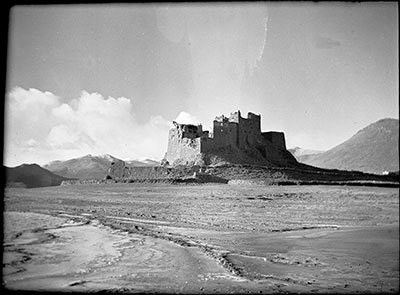
1998.131.176 (Film negative)


1998.131.176 (Film negative)

Frederick Spencer Chapman
Frederick Spencer Chapman
August 20th 1936
Yamdrok Tso Region > Pede dzong
1998.131.176
85 x 113 mm
Negative film nitrate
Donated 1994
Faith Spencer Chapman
British Diplomatic Mission to Lhasa 1936-37
Frederick Spencer Chapman
C.19.7 [view film roll]
SC.T.2.176.neg
In Negative - '7' has been scratched into the negative in the bottom right hand corner [MS 14/01/2005]
Technical Information - This image was probably taken with a quarter plate Zeiss Nixe film or film pack camera as the negative is quarter-plate sized. See Chapman Lhasa The Holy City [London: Chatto & Windus, 1938] for a description of the still and cine cameras that Chapman used as Mission photographer [MS 25/2/2005]
Other Information - Setting: In Lhasa the Holy City [London: Chatto & Windus, 1938; reprint, London: Readers Union Ltd., 1940, pp.61-62] Chapman wrote a description of the setting of this image for August 20th 1936: "All day we rode along beside the lake. I kept a rough check of the pack-animals going south: about 1250 passed us today, of which nearly half were yaks. ... Very often grassy flats lay between the track and the lake, and we could cut across. ... Soon we saw Pede Dzong at the far end of a point running out into the lake. It is just like an old Scottish castle. Unlike Nangartse Dzong it is now ruined. The village lies behind. In the valley nearby barley and peas grow very well in spite of the height. We finished our ride in pouring rain and camped on a flooded field beyond the dzong. There are prayer-flags even here in the water, tied to bamboo poles which are stuck into the bottom of the lake. Spent two hours doing Tibetan, and stayed up till eleven pressing flowers" [MS 7/3/2005]
Other Information - Dates: The date 20th August 1936 has been attributed to this image because the official Mission Diary records that it was on this date that the Mission caravan travelled around Yamdrok Tso to Pede Dzong. However, the photograph may alternatively have been taken during the period 14th - 23rd December when Chapman went on a trip to Yamdrok Tso. He accompanied Evan Nepean, who was returning to Peshawar to resume his military duties, as far as Nagartse. Chapman spent four days around Yamdrok Tso photographing bird life and flora whilst waiting for the arrival of the new commander of the Gyantse Escort, Major Finch, who then travelled with Chapman to Lhasa to spend Christmas with the Mission. Nonetheless, the gathering of rain clouds in the distance was characteristic of the weather in this part of Tibet during August and this alone suggests the earlier date is more likely to be correct [MS 25/2/2005]
Other Information - Setting: Entry in Mission Diary for 20th August, part 3 p.4: "It rained quite hard before and at dawn (about 4-45 am) and went on drizzling till 8am. // The 16 1/2 mile march was all the way along the shore of the Yamdrok Tso, a great lake forming three quarters of a circle some 45 miles long. ...// We had to delay our start [from Nang-Kar-tse camp] after our usual time, because the two Jongpens of course had to go out to see us off a couple of miles from Nang-kar-tse, and we were told they would not be out of bed. We reached Pe-de-jong just in time, as a heavy rain and hail storm started. The mess tent was up and we took refuge. The camp field is covered with white gentian and tiny mauve asters. // There are many signs round this lake of a decrease of population, numerous ruins of houses and abandoned terraced fields and irrigation channels on the hill sides testify to this." [Written by Philip Neame] [MS 25/2/2005]
For Citation use:
The Tibet Album.
"Pede Fort, Yamdrok Lake"
05 Dec. 2006. The Pitt Rivers Museum.
<http://tibet.prm.ox.ac.uk/photo_1998.131.176.html>.
For more information about photographic usage or to order prints, please visit the The Pitt Rivers Museum.
© The Pitt Rivers Museum